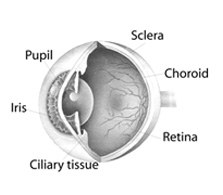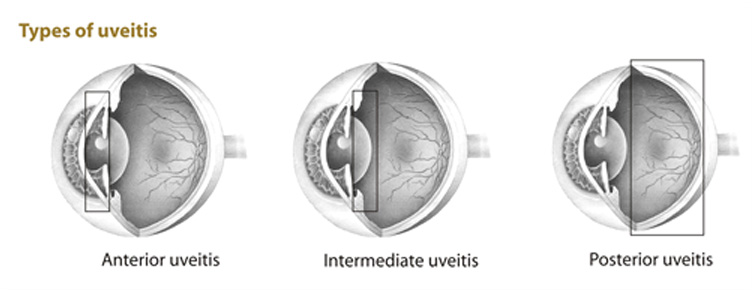
The eye ball consists of 3 layers
- Outer Sclera
- Middle layer – Choroid
- Inner layer – Retina
- Middle layer continues anteriorly as ciliary body and iris
- Choroid, ciliary body and iris together is called Uvea
Uveitis
- Inflammation of uvea (ie) either iris, ciliary body or choroid is called uveitis
- It may either involve one part of the uvea or all the structures
- It is necessary to correctly diagnose the cause of uveitis and treat specifically.
How is your eye affected in uveitis?
- Uveitis causes redness of the eyes, decrease of vision, pain, glare and floaters
- If untreated it may lead to various complications like glaucoma, cataract, corneal opacities and loss of vision.
What causes uveitis?
There are a number of causes of uveitis. It may result from an infection such as bacteria (TB, Leprosy, Syphilis) virus (e.g. Herpes) or a parasite (Toxoplasmosis).
It may be related to an autoimmune disease (with or without involvement of other parts of the body). This, essentially, is when our immune system mistakes a part of our own body as foreign. Trauma to the eye, or even the other eye in the past, can lead to uveitis. In many cases, the cause is said to be unknown. The word “idiopathic” may often be used to describe this group.

Symptoms
- Light Sensitivity
- Blurring of Vision
- Pain
- Floaters
- Redness
Diagnosis
A careful examination of whole body is required as many systemic conditions are associated with inflammation of eye. Examination by an ophthalmologist is extremely important when symptoms occur. Specific blood test is also mandatory.
Treatment
The ophthalmologist should treat the uveitis with equal importance given to both ocular and systemic illness.
The treatment of uveitis aims to achieve the following:
- Relief of pain and discomfort
- To prevent sight loss due to the disease or its complications.
- To treat the cause of the disease whenever possible.
- Like the varied nature of uveitis, the treatment of it may differ from case to case quite considerably.
At times patient may be referred to other specialties for confirmation of the systemic disease. Specific treatment is given for entities like TB or Leprosy uveitis. Corticosteroids are often the mainstay of treatment to control inflammation. But now we have other newer drugs like immunosuppressives that are usually used along with the steroids for immunological causes.
Prognosis
This varies considerably, but there is a growing confidence, especially with the newer drug treatments, that the eyesight can be stabilised over the long term. Uveitis though regarded as incurable, in the sense that it may not completely go away, it can definitely be controlled.
